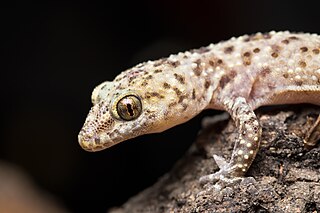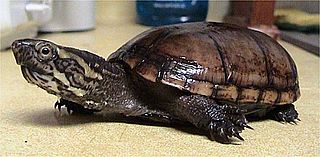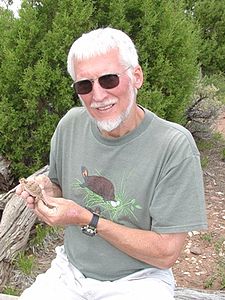
Herpetology is the branch of zoology concerned with the study of amphibians and reptiles. Birds, which are cladistically included within Reptilia, are traditionally excluded here; the scientific study of birds is the subject of ornithology.

Blanding's turtle is a semi-aquatic turtle of the family Emydidae. This species is native to central and eastern parts of Canada and the United States. It is considered to be an endangered species throughout much of its range. Blanding's turtle is of interest in longevity research, as it shows little to no common signs of aging and is physically active and capable of reproduction into eight or nine decades of life.

The alligator snapping turtle is a large species of turtle in the family Chelydridae. The species is native to freshwater habitats in the United States. M. temminckii is one of the heaviest freshwater turtles in the world. It is the largest freshwater species of turtle in North America. It is often associated with, but not closely related to, the common snapping turtle, which is in the genus Chelydra. The specific epithet temminckii is in honor of Dutch zoologist Coenraad Jacob Temminck.

Archie Fairly Carr, Jr. was an American herpetologist, ecologist, and conservationist. He was a Professor of Zoology at the University of Florida and an acclaimed writer on science and nature. He brought attention to the world's declining sea turtle populations due to over-exploitation and habitat loss. Wildlife refuges in Florida and Costa Rica have been named in his honor.

The Indo-Pacific gecko also known as Garnot's house gecko, the fox gecko, or the Assam greyish brown gecko, is a species of gecko found in India, the Philippines, Southeast Asia, Australia, and throughout Polynesia. Adults are about 4 to 5 in in total length. They are seen as dark gray or brown with light markings in daylight and a pale, translucent colour at night. The belly is orange or yellow. The head has a long, narrow snout, hence the name fox gecko. The flattened tail has a row of spiny scales on the lateral edges. The species is parthenogenic – all individuals are female and lay eggs that hatch without requiring male fertilisation.

The Mediterranean house gecko is a species of house gecko common to the Mediterranean area which has spread to many parts of the world. It is commonly referred to as the Turkish gecko as represented in its Latin name and also as the moon lizard because it emerges in the evening.

James Ray Dixon was professor emeritus and curator emeritus of amphibians and reptiles at the Texas Cooperative Wildlife Collection at Texas A&M University. He lived in El Campo, Texas throughout most of his childhood. He published prolifically on the subject of herpetology in his distinguished career, authoring and co-authoring several books, book chapters, and numerous peer reviewed notes and articles, describing two new genera, and many new species, earning him a reputation as one of the most prominent herpetologists of his generation. His main research focus was morphology based systematics of amphibians and reptiles worldwide with emphasis on Texas, US, Mexico, Central America, and South America, although bibliographies, conservation, ecology, life history and zoogeography have all been the subjects of his extensive publications.

Sternotherus odoratus is a species of small turtle in the family Kinosternidae. The species is native to southeastern Canada and much of the Eastern United States. It is also known commonly as the common musk turtle, eastern musk turtle, or stinkpot turtle due to its ability to release a foul musky odor from scent glands on the edge of its shell, possibly to deter predation. This turtle is grouped in the same family as mud turtles.

The razor-backed musk turtle is a species of turtle in the family Kinosternidae. The species is native to the southern United States. There are no subspecies that are recognized as being valid.

The spiny softshell turtle is a species of softshell turtle, one of the largest freshwater turtle species in North America. Both the common name, spiny softshell, and the specific name, spinifera (spine-bearing), refer to the spiny, cone-like projections on the leading edge of the carapace, which are not scutes (scales).
Hobart Muir Smith, born Frederick William Stouffer, was an American herpetologist. He is credited with describing more than 100 new species of American reptiles and amphibians. In addition, he has been honored by having at least six species named after him, including the southwestern blackhead snake, Smith's earth snake, Smith's arboreal alligator lizard, Hobart's anadia, Hobart Smith's anole, and Smith's rose-bellied lizard. At 100 years of age, Smith continued to be an active and productive herpetologist. Although he published on a wide range of herpetological subjects, his main focus throughout his career was on the amphibians and reptiles of Mexico, including taxonomy, bibliographies, and history. Having published more than 1,600 manuscripts, he surpassed all contemporaries and remains the most published herpetologist of all time.

Herping is the act of searching for amphibians or reptiles. The term, often used by professional and amateur herpetologists, comes from the word "herp", which comes from the same Greek root as herpetology, herpet-, meaning "creeping". The term herp is a shorthand used to refer to the two classes of ectothermic tetrapods.
Herpetological society is a commonly used term for a club or organized group of reptile and amphibian enthusiasts. The term is derived from herpetology - the branch of zoology dealing with the study of those organisms.

The eastern mud turtle or common mud turtle is a common species of turtle in the family Kinosternidae. The species is endemic to the United States. There are two recognized subspecies.

Ilya Sergeyevich Darevsky was a Soviet Russian zoologist-herpetologist and a corresponding member of the Russian Academy of Sciences. During his career he described 34 species of amphibians and reptiles. Darevskia, a genus of Caucasian rock lizards, is named after him.
Robert ″Bob″ Powell is an American herpetologist. His main research interest is in the herpetofauna of the Caribbean.

Malcolm L. McCallum is an American environmental scientist, conservationist, herpetologist, and natural historian and is known for his work on the Holocene Extinction. He is also a co-founder of the herpetology journal, Herpetological Conservation and Biology. He is a key figure in amphibian biology and his research has produced numerous landmark studies. His work has been covered by David Attenborough, Discover Magazine, and other media outlets.

Stanley E. Trauth was born September 5, 1948, in St. Louis, Missouri, but moved to Arkansas as a child in 1955. He is an American herpetologist and professor of zoology and environmental studies at Arkansas State University. He is also the curator of the herpetological collection of the Arkansas State University Museum of Zoology.
Joseph Thomas Collins, Jr. was an American herpetologist. A graduate of the University of Cincinnati, Collins authored 27 books and over 300 articles on wildlife, of which about 250 were on amphibians and reptiles. He was the founder of the Center for North American Herpetology (CNAH). He died while studying amphibians and reptiles on St. George Island, Florida on 14 January 2012. "For 60 years I was obsessed with herpetology," claimed Joe Collins
C. Kenneth Dodd Jr., is an American herpetologist and conservationist. He earned his Ph.D. under Edmund D. Brodie Jr. from Clemson University in 1974. From 1976 to 1984 he worked in the research division of the U.S. Fish and Wildlife Service, then he transferred to the U.S. Geological Survey in 1984, where he remained until his retirement in 2007. He is currently Courtesy Associate Professor in the Department of Wildlife Ecology and Conservation, University of Florida and an Affiliate of the Florida Museum of Natural History. He has published over 200 papers, reviews and books. Much of his research focuses on turtle and amphibian ecology/conservation. He, along with R. Bruce Bury and Garry Fellers were the first to suggest widespread amphibian declines were progressing. He is a nationally recognized herpetologist.














